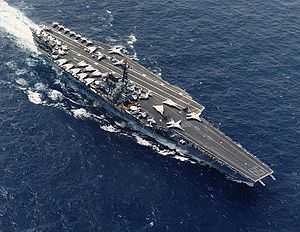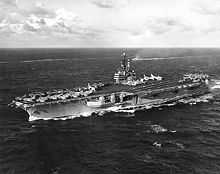Forrestal-class aircraft carrier
 USS Forrestal | |
| Class overview | |
|---|---|
| Name: | Forrestal-class aircraft carrier |
| Builders: |
New York Navy Yard Newport News Shipbuilding |
| Operators: |
|
| Preceded by: | Midway class |
| Succeeded by: | Kitty Hawk class |
| In commission: | 1 October 1955 – 30 September 1998 |
| Completed: | 4 |
| Laid up: | 4 |
| General characteristics | |
| Displacement: | 60,000 tons[1] |
| Length: | 1,070 ft (330 m) 990 ft (300 m) waterline |
| Beam: | 129 ft 4 in (39.42 m) waterline |
| Draft: | 35 ft 9 in (10.90 m) |
| Propulsion: | Steam turbines 280,000 shp |
| Speed: | 34 knots (63 km/h) |
| Complement: | 4,378 |
| Armament: | Original armament:
Refit armament:
|
| Aircraft carried: | Up to 90 |
| Aviation facilities: | 326 × 77 m flight deck |
The Forrestal-class aircraft carriers were a four-ship class designed and built for the United States Navy in the 1950s. It was the first class of so-called supercarriers, combining high tonnage, deck-edge elevators and an angled deck. The first ship was commissioned in 1955, the last decommissioned in 1998.
Design

The Forrestal class was the first completed class of "supercarriers" of the Navy, so called because of their then-extraordinarily high tonnage (75,000 tons, 25% larger than the post-World War II-era Midway class), full integration of the angled deck (Forrestal and Saratoga were laid down as axial deck carriers and converted to angled deck ships while under construction; Ranger and Independence were laid down as angled deck ships and had various minor improvements compared to the first two), a very large island and most importantly their extremely strong air wing (80–100 jet aircraft, compared to 65–75 for the Midway class and fewer than 50 for the Essex class). Compared to the Midway class, the Forrestals were 100 feet (30 m) longer and nearly 20 feet (6 m) wider abeam, resulting in a far more stable and comfortable aircraft platform even in very rough weather. When commissioned, the Forrestal-class ships had the roomiest hangar decks and largest flight decks of any carrier ever built. Because of their immense size they were built to a new, deep-hulled design that incorporated the armored flight deck[2][3] into the hull (previous American design practice was to design the flight deck as superstructure). This was a very similar structural design as used on British "armored" carriers, and grew out of the requirement for such a very large carrier, because carrying the strength deck at the flight deck level produced a stronger and lighter hull.[4] The Midway-class ships sat very low in the water and were poor sea boats through their long careers; they were very wet forward and their aviation characteristics were poor. The deeper Forrestal hull allowed the ships more freeboard and better seakeeping. The Forrestal-class carriers, like the Midway class that preceded it, were designed with armored flight decks.[5][6][7][8]

_and_USS_Saratoga_(CV-60)_underway_crop.jpg)
Forrestal-class ships were the first examples of supercarriers and thus not quite a perfected design; their elevators in particular were badly arranged for aircraft handling. The portside elevator, a relic of the original axial-deck design, was especially poorly suited, as it was located at the fore end of the angled deck, in the landing path as well as the launch path of aircraft from the #3 and #4 catapults. The subsequent Kitty Hawk class moved the portside elevator to the aft end of the angle and reversed the position of the island and the second starboard elevator, vastly improving aircraft handling. The sponson-mounted guns suffered from poor range and complicated firing arcs, and were located in very wet and thus nearly useless positions in the bow and stern. They were removed after only a few years and were later replaced by missiles and much later by close-in weapon systems (CIWS). The aft guns in Forrestal lasted until the fire in 1967, then were removed and eventually replaced by missiles in the mid-70s.
The original design of the Forrestal-class ships would have had a very small, retractable island; this design had numerous problems (the mechanism to raise and lower the island was never perfected before the angled deck was added to the design) and smoke fouling of the deck was expected to be a severe problem due to lack of adequate venting. The redesign to an angled deck allowed a very large island, much larger than on previous carriers, giving unprecedented flexibility and control in air operations.
All four ships have been struck from the Naval Vessel Register. One, ex-Ranger, was on donation hold as a potential museum ship, but as of September 2012, all four have been designated for dismantling.[9]
Ships in class
| Name | Builder | Ordered | Laid Down | Launched | Commissioned | Decommissioned | Fate | Source |
|---|---|---|---|---|---|---|---|---|
| Forrestal | Newport News Shipbuilding and Drydock Co., Newport News | 12 July 1951 | 14 July 1952 | 11 December 1954 | 1 October 1955 | 11 September 1993 | Broken up at Brownsville, 2014 | [10] |
| Saratoga | New York Naval Shipyard, New York City | 23 July 1952 | 16 December 1952 | 8 October 1955 | 14 April 1956 | 20 August 1994 | Broken up at Brownsville, 2014 | [11] |
| Ranger | Newport News Shipbuilding and Drydock Co., Newport News | 1 February 1954 | 2 August 1954 | 29 September 1956 | 10 August 1957 | 10 July 1993 | U.S. Navy paid 1 cent to International Shipbreaker's of Brownsville, TX to tow and scrap Ranger on 22 Dec. 2014 | |
| Independence | New York Naval Shipyard, New York City | 2 July 1954 | 1 July 1955 | 6 June 1958 | 10 January 1959 | 30 September 1998 | To be towed to Brownsville for scrapping within 2015 |
Gallery
-

USS Forrestal (CVA-59)
-
.jpg)
USS Saratoga (CVA-60)
-

USS Ranger (CVA-61)
-

USS Independence (CVA-62)
-

Forrestal (left) and Saratoga (right) laid up awaiting disposal at NS Newport in 2003
References
This article incorporates text from the public domain Dictionary of American Naval Fighting Ships.
- ↑ Donald, David; Daniel J. March (2001). Carrier Aviation Air Power Directory. Norwalk, Connecticut: AIRtime Publishing. ISBN 1-880588-43-9.
- ↑ USS FORRESTAL (CVA-59):"Over a dozen 1,000 and 500 pound bombs detonated within the first few minutes of the fire, punching holes through the 3" armor plating of the flight deck."
- ↑ Cracknell, W.H, Cmdr USN, Warship Profile 15, USS Enterprise (CVAN 65) Nuclear Attack Carrier, p.56: "The main armor carried on Enterprise is the heavy armored flight deck. This was to prove a significant factor in the catastrophic fire and explosions that occurred on Enterprise's flight deck in 1969. The US Navy learned its lesson the hard way during World War II when all its carriers had only armored hangar decks. All attack carriers built since the Midway class have had armored flight decks."
- ↑ Friedman, Norman, U.S. aircraft carriers: an illustrated design history, Naval Institute Press, ISBN 0-87021-739-9, P.250
- ↑ CV-59 FORRESTAL class:"As the first aircraft carrier designed specifically for jet aircraft, she featured an armored flight deck."
- ↑ Forrestal class attack aircraft carriers:"Armor: hangar, flight deck and magazines protected"
- ↑ Forrestal Class
- ↑ USS Forrestal Memorial (CVA/CV/AVT-59) July 29, 1967: "The explosions tore large holes in the armored flight deck..."
- ↑ http://www.navsea.navy.mil/teamships/Inactiveships/pdf/Inactive_Fleet_Inventory10Dec2012.pdf
- ↑ "Departure time set for USS Forrestal". Philadelphia Inquirer. Retrieved 3 February 2014.
- ↑ Navy pays 1 cent to scrap ex-carrier Saratoga. Navy Times. May 8, 2014. Accessed May 8, 2014.
| ||||||||||